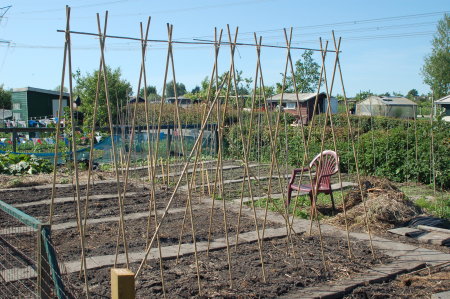
In my community garden this seems to be the standard design for a bean support structure. I haven’t really seen them before, so it’s probably not a really wide spread thing, and a lot of people in my garden are from other countries so this may not even be a Dutch design per se.
In my case, it’s 10 poles on each side intersecting at the top and tied to a horizontal pole. In addition, on both sides are diagonal poles for extra support. Wind is a real issue here, and this is clearly intended to stand up to a lot of it. I see some people using single poles, but otherwise everyone else uses this design.
I didn’t have any pole beans last year in the garden, so this is my first year trying this. Does anyone else use this design, or something similar?


We use cones or “wigwams” of 8 or 10 canes bound together at the top. I like that design as it lets you dot them in here and there where you have a space (occasionally in the back of the flower border for example). I suspect the results are much the same.
That’s the suport design everyone uses around here (me included). It works really well for me, I think you will like it. It also allows me to use the space under the beans to grow winter squash.
I use single poles, saved when we cut our firewood (we have a lot of trees). The trick with them is to use an iron drop bar to make a deep hole, as the poles are too tall to hammer into the ground. With a row of single poles, air circulation is better, which is very important here in the late summer to get the beans as dry as possible. I run the rows along the north side of beds with potatoes, etc in the bed in front
I use this design but sometimes cross the poles lower down so that I can access the beans that are at the top of the plants more easily.
I see a lot of constructions like this, with one or two people building them out of scaffolding poles. The only drawback I can see is that when they’re covered by the plants, they can really catch the wind. The site is very sheltered, but Ive still seen them go down. I use wigwams, and the worst that’s ever happened is that they’ve been blown lopsided, and that peas have been wrapped round them in a dreadful tangle!
This is standard design for bean supports on British allotments. The short cross bracing on the sides is important for structure rigidity.
We have often used this method but this year we’re using hazel coppice rods in a wigwam formation, mainly because I had to erect them by myself. The other way is much easier with two people to build it.
That is exactly the sort of support my dad always used for runner beans in his garden so I think it is probably a pretty traditional form – he was born in 1910 so didn’t do anything new-fangled.